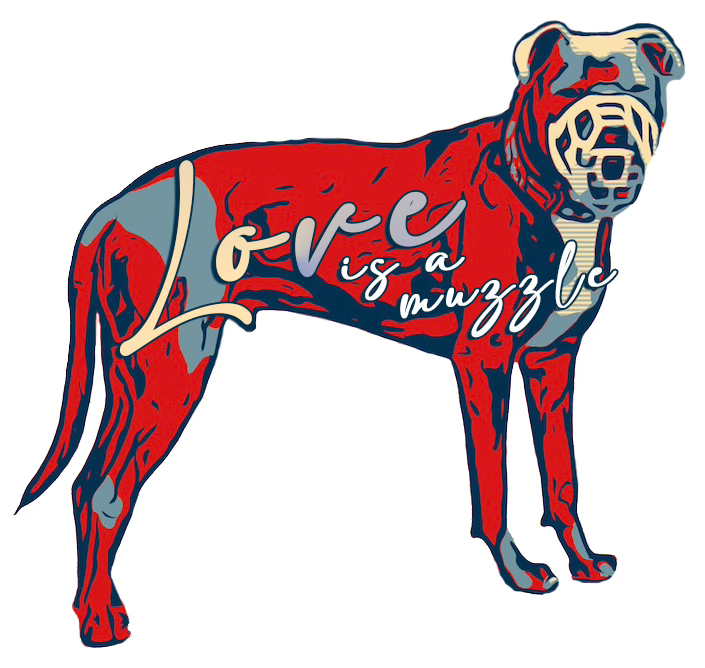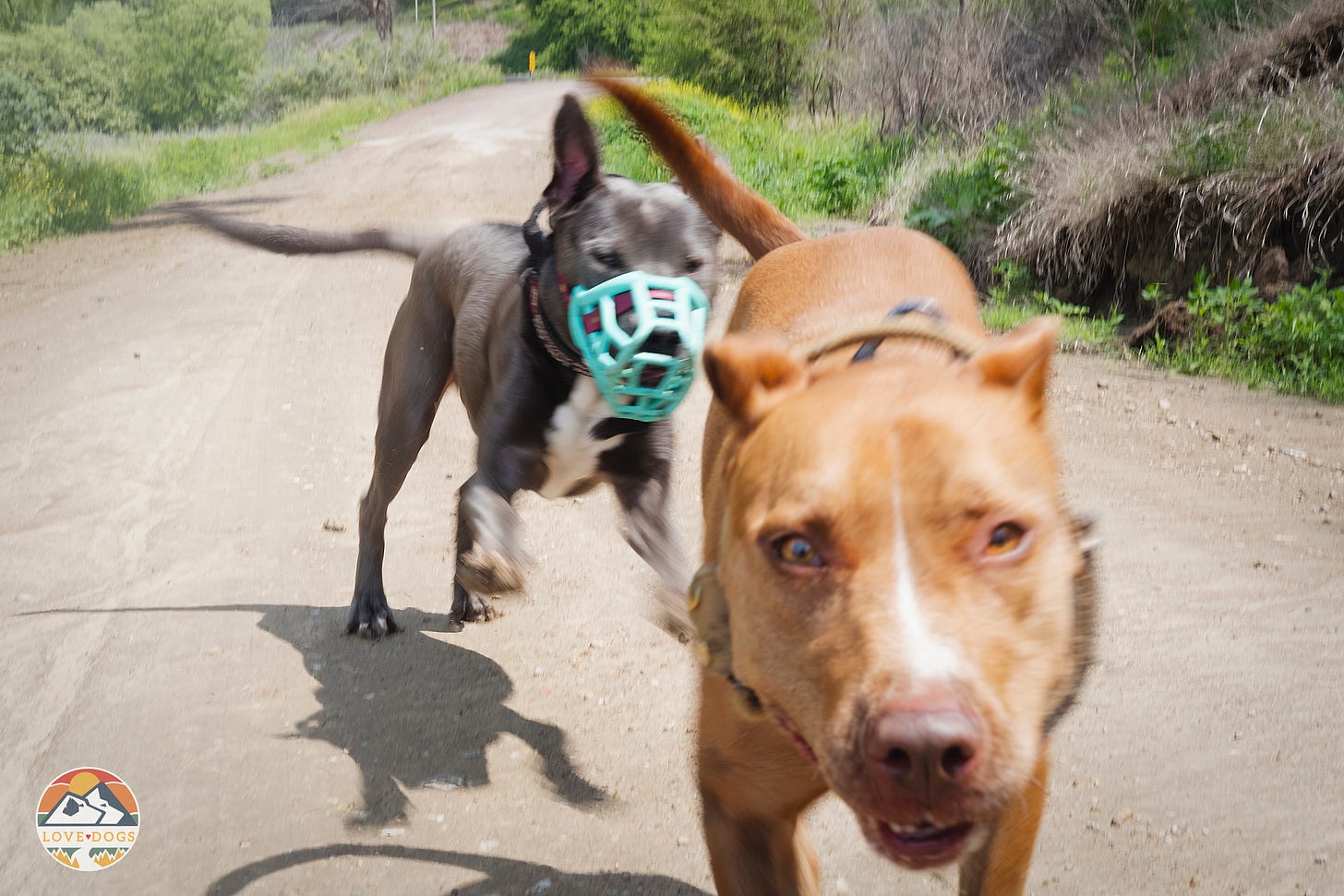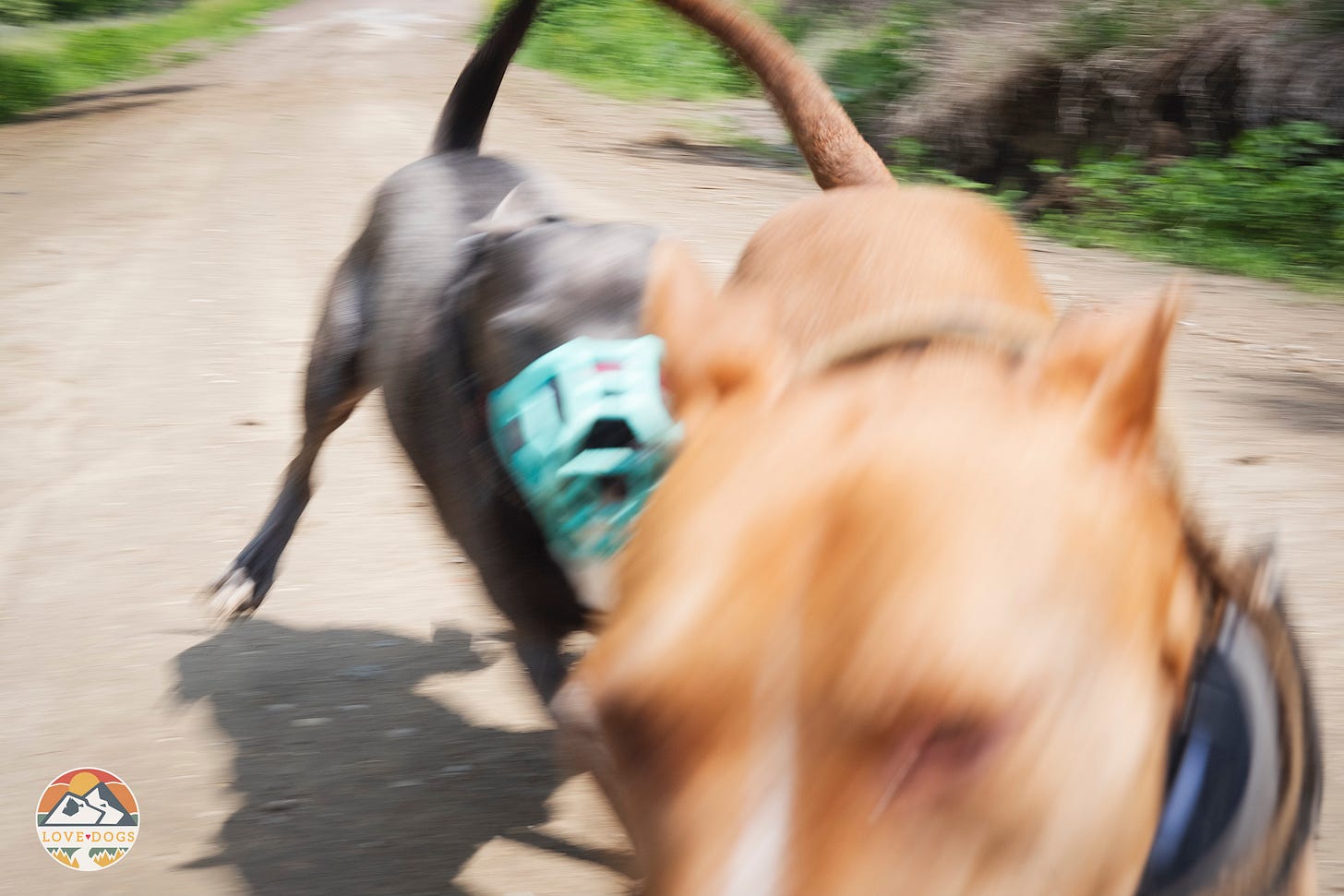Read part one of our muzzle journey here: https://lovedogs.substack.com/p/good-dogs-wear-muzzles
I was fully prepared to do videos of our entire muzzle-training process and write a detailed guide until I found the video below by Blue Cross UK. This is the best muzzle training video I’ve seen, and it is precisely how I trained Japhy. Click below to watch.
I did write up a few of my own thoughts and tips (shared below). And I even started recording a video series before I found Blue Cross UK’s video, which really is fantastic, so there’s no reason to “reinvent the wheel” as they say. I included a couple of our own videos of “the first step” below just for comparison. As you’ll see in the video of Japhy, he is already well-familiar with the muzzle. He started shoving his nose into the muzzle before I even said the cue, because, well, this is not his first rodeo. As a result, and so you can see what it looks like to do this with a dog who’s never worn a muzzle, I decided to record a video with Hazel instead, using Japhy’s muzzle (because she doesn’t have one yet). Note that Japhy’s muzzle is too big for Hazel, but it works for the purpose of initial introduction. The cue I’m using is “muzzle-up.” For the first step, you really don’t need a cue, but I also don’t think there’s any harm in using one from the beginning. I did end up buckling the muzzle with Japhy, just to demonstrate it, but with a dog who’s never worn a muzzle before, I would wait until they are very, very comfortable with just putting their nose into the muzzle (and being able to back out of it) before buckling the strap.
Some Tips:
Find a proper fitting muzzle.
I think this is THE most important piece of the muzzle training puzzle. An uncorrected ill-fitting muzzle may delay or complicate your training progress. It may also cause abrasions from parts of it touching and rubbing the wrong areas of the face. If you read the first part of our muzzle journey, you know that we went through three or four muzzles before finding The One for Japhy. Finding one that fits well (and has the features we like) really did make ALL the difference for us. It might seem overwhelming to approach muzzle training at first, when you don’t know where to start. I felt this way when starting with Japhy. Please believe that you and your dog can do it! Take your time. Don’t force your dog to wear the wrong muzzle for him/her. Ask your veterinarian or a local dog trainer for help. Try to borrow some muzzles before buying, if you can, or find a trainer or seller who offers muzzle fittings in your area. If none of these options are available to you, it may be necessary to carefully read the measurement directions for specific muzzles and be willing to spend some money to try one or two. Many places do offer returns or exchanges if the fit isn’t quite right the first time, so long as the muzzle remains in like-new condition (maybe don’t smear peanut butter all over it right away 😆). Don’t be afraid to ask questions. If a seller isn’t willing to take the time to answer, then it’s probably not the right muzzle.
Look for helpful features/add-ons
Metal Quick-release Clip. If you have a dog who doesn’t like being handled (particularly when it comes to fitting gear), fiddling with a buckle strap is probably going to frustrate you both. I recommend getting a muzzle with a quick-release clip instead. It’s much easer/quicker to fasten and unfasten.
Treat Hole. If you’re not concerned about your dog scavenging, I’d also recommend getting a muzzle with a treat hole. It makes training a lot easier, and it allows you to offer your pup yummy treats at any time while the muzzle is on.
Scavenger Guard/No Treat Hole. If you are concerned about your dog’s scavenging tendencies, The Muzzle Movement actually makes a scavenger guard that pops right into the treat hole for those outings where you want to make sure your dog doesn’t pick up some random thing and gulp it down before you can say “leave it.” It’s possible that other muzzle makers offer something similar, and it doesn’t hurt to ask. Otherwise, maybe consider getting a muzzle that doesn’t have a treat hole, because Japhy has proven that it absolutely is possible to suck down a road-kill rabbit leg through the treat hole of a muzzle!
Material. Basket muzzles are available in various styles and materials. We tried one made of biothane that ended up being too big for Japhy. The straps on that particular muzzle could be flexed enough that I’m pretty sure he could’ve pawed it off his head if he wanted to. The one we’re using now is made of injection-molded polyethylene (plastic). It does not bend, so pawing it off is less a concern as long as you have the correct fit. One reviewer on the MM website says that “the insides are sharp,” however this is not the case with ours, and I do think that any such areas could be sanded down and rounded out with minimal effort. There are also wire basket muzzles, as well as leather ones. Research each one, and go with what you think will be best for your dog.
Ease of Cleaning: Japhy’s muzzle is really easy to clean, and that’s a good thing, because he is constantly shoving it into all kinds of things, from road-kill to mud to poop. :) I have tossed it in a bucket of soapy water to soak, I have put it under the faucet and cleaned it with a rag, and I have used all-natural wipes to clean it without water.
Weight. This probably isn’t a huge concern for most, but if you have a smaller dog, or if you’re a backpacker and you want to pack the muzzle on trips (which is what we will do now that we have it), it might be good to at least know the weight. The size Tolly from The Muzzle Movement weighs around 6 ounces. Pretty lightweight for a muzzle!
For a list of add-ons offered by The Muzzle Movement, click here. This might give you an idea of what’s available, and companies that make custom muzzles might offer similar features.
Additionally, The Muzzle Movement’s list of FAQs is really informative.
For even more reading, I wrote about muzzle training in the TiFBiTS weekly newsletter (a new thing I’m offering that features tidbits of info about art, nature, dogs, and van/life in one Friday-published newsletter). You can read the issues about muzzles by clicking the links below and then scrolling down to “Dogs.” And if you’re interested in the other tidbits offered in that newsletter, feel free to subscribe!
Volume 1, Number 1: https://tifholmes.kit.com/posts/tifbits-vol-1-no-1
Volume 1, Number 2: https://tifholmes.kit.com/posts/tifbits-vol-1-no-2
Volume 1, Number 3: https://tifholmes.kit.com/posts/tifbits-vol-1-no-3
I know it sounds like I’m working for The Muzzle Movement (I promise I get zero kickbacks for promoting them), but their muzzle has made such a huge positive difference for us. I want others to know that this kind of difference is possible. Don't give up. It can all seem overwhelming at first, but it’s definitely worthwhile to keep your adventure dogs safe.
As a reminder: I’m turning off paid subscriptions here on Substack. If you received an email saying you’ve been unsubscribed as a paid member, that’s why. I apologize for any inconvenience, and I do appreciate the support (very much!). Unfortunately, Substack is not yet a particularly supportive platform when it comes to small-beans writers like myself and sales tax liability for national and especially international paid subscription income. If you would like to continue your paid support of the Love Dogs, please consider joining our Patreon community at whatever level you desire (you can create your own tier!). Patreon takes care of the sales tax and VAT for me, which means I can write more and stress less about my tax obligations. Again, thank you so much for your support! It means a lot. If you have questions about Patreon, don’t hesitate to reach out. I’m happy to help.









Extremely helpful! Thank you.